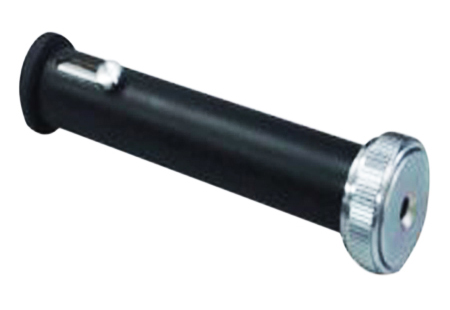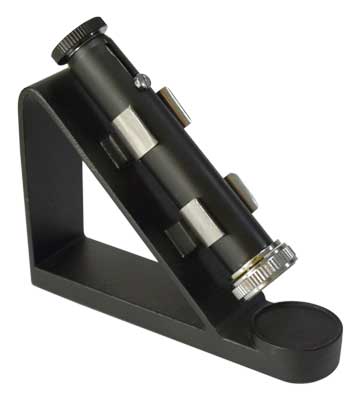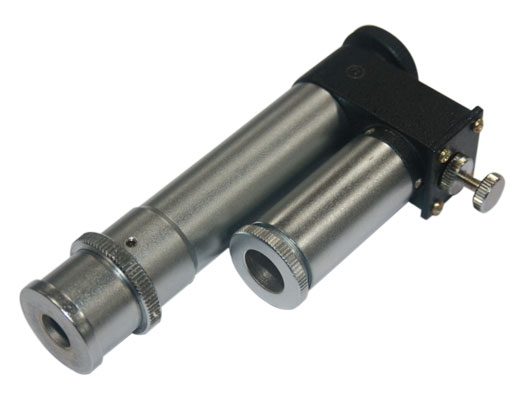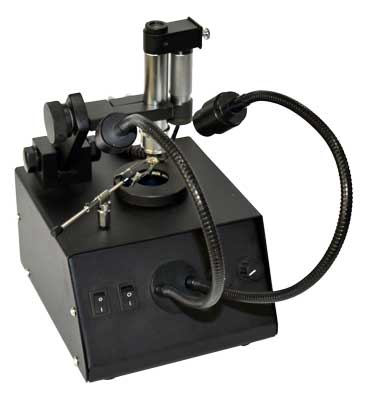Direct Vision Spectroscope
Direct Vision Spectroscope Without Wavelength Scale

RDV-1 - A complete and light weight direct vision spectroscope without wavelength scale, for observing visible radiations from 400 to 750mm.
Prism Spectroscope RDV-1S

Direct Vision Spectroscope With Wavelength Scale
RDV-2 - A compact visible spectroscope which allows the direct reading of spectral length and employs a prism for dispersion. It is also useful for flame test of basic radicals (sodium, strontium, potassium, copper etc.)
 There is a single eyepiece and independent focussing tube for the graticule, which carries an index at 590mm. with "D", marked right below the scale, (corresponding to the wave length of sodium light) can be calibrated to a known light source by adjustment of knurled screw. The amount of light admitted to the spectroscope can be regulated by a variable slit, adjusted by a knurled ring round the rating tube.
There is a single eyepiece and independent focussing tube for the graticule, which carries an index at 590mm. with "D", marked right below the scale, (corresponding to the wave length of sodium light) can be calibrated to a known light source by adjustment of knurled screw. The amount of light admitted to the spectroscope can be regulated by a variable slit, adjusted by a knurled ring round the rating tube.

Gem Illuminated Spectroscope RDV-77
Gemological spectroscope separates white light into its components spectral colors ranging from 400 to 700nm. When a gem under a test is illuminated properly with white light and observed through a spectroscope, chemical ingredients present in it absorb some wavelengths which are absorbed by the gem appear as dark lines or brands on the spectrum. Such spectral pattern is specific for certain types of stones and help to identify and separate from look a likes.
Absorption spectrum gives an indication of the coloring elements present in the gemstone, thereby assisting in its identification. In some cases spectral pattern helps to separate natural gemstones from their synthetic (dyed) counterparts.
 A spectroscope for visible light shows the absorption lines of the elements involved in producing its color. For instance, it helps to separate ruby (chrome) against red or pink sapphire (iron). Spectroscope breaks up the light that is being transmitted from a gemstone to its spectral colors. The process allows the gemologist to see the various wavelengths absorbed by the gemstone. Making this one of the most important tools in identifying gem. Spectroscopes allow you to analyze a loose or mounted stone and they also help to distinguish natural stones from synthetics by the stone a selective absorption of certain wavelengths.
A spectroscope for visible light shows the absorption lines of the elements involved in producing its color. For instance, it helps to separate ruby (chrome) against red or pink sapphire (iron). Spectroscope breaks up the light that is being transmitted from a gemstone to its spectral colors. The process allows the gemologist to see the various wavelengths absorbed by the gemstone. Making this one of the most important tools in identifying gem. Spectroscopes allow you to analyze a loose or mounted stone and they also help to distinguish natural stones from synthetics by the stone a selective absorption of certain wavelengths.
Technical Specifications:
Double adjustable light source with 3W LED.
Adjustable light well: 2-28nm, Continuous exactable.
Adjustable slit and draw-tube focus & Gem clamp.
Wavelength scale (range from 400 to 700nm).
The scale illumination is connected to a cold light source with 0.5W LED.
Adjustable intensity of tungsten-halogen illumination 6V – 20W.
Worldwide voltage: 100V-240V.
Applications:
Gemological laboratory, gemology, gem & jewelry industry --etc.
Absorption spectrum gives an indication of the coloring elements present in the gemstone, thereby assisting in its identification. In some cases spectral pattern helps to separate natural gemstones from their synthetic (dyed) counterparts.

Technical Specifications:
Applications:
Gemological laboratory, gemology, gem & jewelry industry --etc.
INSTRUMENTATION SINCE 1975 © 2024 Radical Scientific Equipments Pvt Ltd, All rights reserved




